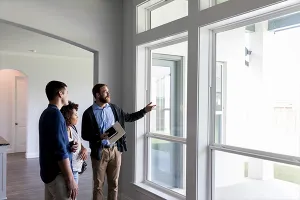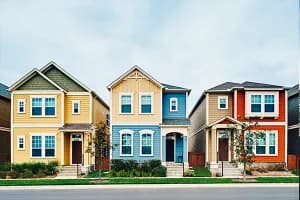Prognosticating during a recession as long and deep as we have seen the last couple of years is a tricky business, indeed. Is this a pause in pre-existing trends that will resume once the down cycle ends? Or is it a reset that creates entirely new conditions, the period at the end of one sentence and the capital letter of the next?
Prior to the real estate crash, one of the hottest new trends in development brought us projects and proposals aimed at “retrofitting” conventional, automobile-oriented suburbs into more walkable, transit-ready urban places. Suburban communities from Smyrna, Ga., to Lakewood, Colo., were building the town centers they had never had before. Plans were drawn up to re-imagine aging commercial strips as strings of compact new neighborhoods of multistory apartments, condominiums and offices over street-level shops and restaurants.
Demographic, cultural and myriad other factors seemed to point in this direction. First, the traditional market for conventional, new suburbs on the metropolitan fringe was beginning to shrink, as the share of households without children began to dwarf the share of those with kids. In the coming years, up to 85 percent of new households will be without children, demographers predict. In part this is because the baby boomers — for whom the now-aging suburbs were built as child-rearing havens — are moving beyond child-rearing themselves and looking toward retirement, while younger couples are delaying childbearing.
At the same time, crushing commute times in the large metros were leading many to look for homes closer in, and the older, inner-ring suburbs suggested themselves as likely locations. They are closer to job centers, generally, and often can be connected to existing public transit lines. Some local governments — seeking to reverse the blight that followed when older shopping centers were abandoned for sleek, new locations farther out— also were bending over backward to make redevelopment happen, offering tax-increment financing and other incentives to lure redevelopment.
Even those enticements, though, have not been enough to make deals happen in a real estate recession that has made financing for new projects nearly impossible. Some of the projects that did get underway sit half-completed, or completed and half-empty. Now, some wonder whether suburban retrofits were more a product of speculative over-development than response to real market demand, and question their future.
One who does not is June Williamson, who last year co-authored with Ellen Dunham-Jones, a book on the topic, titled “Retrofitting Suburbia: Urban Design Solutions for Retrofitting Suburbs.”
“There is no doubt that we will need new construction as the population grows in the coming years, and the overwhelming percentage of that growth will be households without children,” says Williamson, associate professor of architecture at City College of New York/CUNY. “That demand will be met with smaller units or multifamily, and most are likely to be in suburbs.”
A “50-year project” in need of a quick start
Williamson and Dunham-Jones, former director of the architecture program at Georgia Tech, expect the refashioning of older suburbs to be a 50-year project akin to the building of suburban America itself. But they also feel a sense of urgency about laying the groundwork for that project. While population is surging toward an expected 400 million by mid-century, vast swaths of failing commercial development are hammering property values and local budgets. Meanwhile, rising fuel prices, combined with a national need to reduce oil consumption and climate-harming emissions, augur an urgent need to reduce commute distances and over-dependence on cars, they argue.
The authors acknowledge, however, that many challenges remain before retrofitting suburbia can begin to match the scale and pace of the original wave of suburbanization, and that not every metro market is ready. Those that have seen the most activity tend to be two types. Some are older markets, mostly in the Northeast, that are so “built out” that parking lots and dead shopping centers represent the most viable locations for new housing. The most active have been the coastal cities and Sunbelt boomtowns that have seen rapid growth and are attracting the younger workers who seek urban locations. The most successful have made a commitment to rail transit — light rail, subways or streetcars— and have some constraints on outward sprawl, whether because of geography, overly long car commutes or regulatory limits. The other X factor is whether local governments are active and flexible enough to create the zoning, taxing and financing conditions to make complex development projects possible.
“The hot metro areas for suburban retrofits so far are Washington, D.C., Denver and Atlanta,” says Dunham-Jones. Washington’s concentration of federal workers, high in-town housing prices and extensive Metrorail network have led to major developments around suburban rail stations. In Denver, the Rocky Mountains partially constrain sprawl while a burgeoning light rail system is drawing development to some suburban nodes. And in Atlanta, limits to extending transportation and water infrastructure, combined with increasingly punishing commutes are conspiring with an influx of younger, urban-oriented workers.
Efforts to retrofit suburban areas have taken several reforms. Future projects are likely to build off some of the models that follow, Williamson and Dunham-Jones say.
Redevelopment
The most transformative — but also complex — retrofits are wholesale redevelopments of dead or dying malls or strip corridors. One of the best examples attempted so far, Dunham-Jones says, has been the transformation of the failed Villa Italia mall in Lakewood, Colo., into Belmar. After the mall died in the late 1990s, the town tried in vain to find a developer willing to update and reopen it.
“A developer, Continuum Partners, said ‘I won’t fix the mall but I’ll give you the downtown you never had,’” Dunham-Jones recounts. Now about two-thirds complete, the former mall site has been converted to 22 city blocks on 103 acres, with shops, restaurants, cafes, theaters, offices, residences, artist studios, parks and plazas.
“Some may complain that building everything at once makes it feel less than authentic,” says Dunham-Jones. “But the construction and architectural detailing are good enough that it creates the bones for urbanization over time.” She also praised the project for connecting well to surrounding neighborhoods so that the project does not feel like an isolated development.
Re-inhabitation
Full-scale redevelopment is incredibly complex, requiring a combination of the right property at the right price, local government participation, patient capital and market conditions. The low-hanging fruit of suburban retrofits are what Dunham-Jones calls “re-inhabitation,” or the adaptive reuse of former retail spaces. “You’ll see a dead mall becoming a community college, an old grocery store becoming a library. Many of those that are adapted become community serving — libraries, schools, churches.”
“Part of what we’re seeing in older suburbs is a welcome rounding out of more community-serving uses,” Dunham-Jones adds. “You’re seeing mom and pop retail coming in places that used to be exclusively national retailers. These are becoming more unique places, attracting immigrant populations.”
However, one challenge to re-inhabitation and this incremental overhauling is for communities to find the resources to retrofit dangerous arterial highways to be more hospitable to neighborhood uses, so that a kid might be able to bike safely to a library, or an older adult cross the road to a senior center.
Re-greening
Not only are dead and dying malls visual eyesores and a drain on the local tax base, but ecologists consider their surface parking to be one of the built environment’s gravest insults to the natural environment, smothering life, reflecting heat, fouling watersheds. But many communities are taking advantage of the availability of these parcels to create new parks, wetland reserves, community gardens and other open space. Think of it as the reverse of the Joni Mitchell line in “Big Yellow Taxi”— “They paved paradise and put up a parking lot.”
In Phalen, a suburban area outside St. Paul, Minn., the city bought a failed, 1959 strip shopping center and created a new public park by uncovering the wetlands and creek that had been covered by the parking lot. “Before the Clean Water Act, building over wetlands and creeks was very common in suburbs, because high land was used for residential,” Dunham-Jones says. “As culverts begin to fail, as happened here, it makes sense, rather than try to fix it, to restore it to wetland. The resulting lakefront can then become desirable property in what had been rundown area.”
Rezoning
Many communities across the country are using the lull in real estate activity as an opportunity to lay the framework for future development. “Now is the time to do the planning,” Dunham-Jones says. A number of communities have taken this to heart in the Washington, D.C. area, alone. Arlington, Va., of course, led the way in suburban retrofits 30 years ago with its plans to reshape a corridor characterized by strip centers and auto lots into a series of new town centers along the Metro rail line.
A few miles away, Arlington County is trying to replicate the success along the Columbia Pike commercial corridor. But this time, rather than follow planned transit, they are using zoning codes and other inducements to create dense nodes that can serve as enticement to light rail or streetcar. By upzoning at intersections and coding for mixed-use, multistory buildings, planners already have lured eight-plus-story buildings. It is hoped that the taxes from those nodal developments will support future rail.
Just this March, nearby Montgomery County, Md., unanimously adopted a plan to transform aging suburban commercial development into a new town at the White Flint Metro station. The White Flint Sector plan calls for 2,600 affordable housing units, parks and plazas, daycare centers, hotels, retail, a conference center, and walking and bicycling trails. It creates a new zoning designation that requires developers to select from a list of amenities that must be provided in exchange for maximum allowable densities. Buildings will be permitted to reach 30 stories in the core area at the Metro station, while tapering down to match the conventional suburban densities of surrounding neighborhoods.
Upon passage, Montgomery County Council member Roger Berliner said in a prepared statement: “When you look at the area today, it is hard not to be struck by the large amount of asphalt found in the strip malls and surface parking lots. Asphalt is not the highest and best use of this incredibly important real estate. … Those who live in and around White Flint will be able to take advantage of the numerous public spaces, bike trails and walking paths as well as the public amenities that make a neighborhood feel like a neighborhood — a library, a recreation center, a new school and a beautiful, substantial civic green that will serve as a meeting place for the community.”
Repurposing
The suburbs most in need of retrofitting today are those that sprang up in the 1950s and ‘60s to accommodate the post-war surge in families with children. In one of the supreme ironies of our era, the urban form propagated in order to raise up this cadre of baby boomers now has to be remade as a place where many of them will live out their last days. Accommodating this “silver tsunami” is one of our greatest planning challenges, says Scott Ball, an architect and urban designer and author of the forthcoming “Longevity and Urbanism.”
In metro Atlanta, where the over-60 population is expected to double from 2005 to 2020, the regional planning agency sought to address the issues in a unique planning exercise last year. The Atlanta Regional Commission brought together experts in health care, aging, transportation, accessibility, architecture, planning and urban design to explore the challenges of retrofitting the suburban landscape — where most baby boomers live— into “lifelong communities” that support people of all ages. The work began with an intensive, multiday charrette — a collaborative planning and design process — that used five prototypical sites throughout the region as living laboratories for retrofits. Led by noted new urbanist Andres Duany, the charrette produced conceptual master plans for each site, incorporating mixed-use, mixed-income, multigenerational designs that promote physical activity and healthy living; model standards and zoning codes for other such “lifelong communities;” and principles for regional planning and development to meet the needs of older adults.
Scott Ball, a senior project manager at Duany Plater-Zyberk & Company who was the project manager for the charrette, said that one of the first principles to emerge was that “aging is a litmus test for livability for all. The whole principle is to integrate older adults as long as possible into the community. When you start to deal with their issues as separate from those of others in the urban environment, you get age-restricted communities and specialized housing that disconnects people from the larger community.”
Indeed, connecting homes to services, to opportunities for exercise, to places to see and be with other people, is paramount. “The first thing you have to deal with is the connectivity issue: weaving in a functional street grid that connects to other neighborhoods and is less reliant on large arterials,” Ball says. “In cul de sac development you get isolation, from people, from services. There are important details to remember — putting in a curb cut for wheelchairs, the right kind of entry way and so on— but you have to have the street grid first.”
“There’s no doubt that the market for ‘lifelong communities’ is vast,” Ball said. “Since the Atlanta charrette, requests for advice and consultation have been coming fast and furious from communities across the country.”
Reality
While market forces will continue to drive the trend, and existing models show the way, retrofits are likely to continue to be hampered into the next real estate cycle. Conventional suburban development is highly standardized into a relative handful of product types — whether big-box centers, garden apartments or office parks —that make financial underwriting relatively easy. With retrofits, every deal is custom, and often complicated by public participation, through tax increment financing or other tax credit programs, says Williamson.
“Over time, there is a likelihood that there will be more standardization. But by its very nature, having a mixed use, walkable place requires paying attention to the context, so the design and operations will be as multiple as the places,” she adds. “Once there is a track record there should be less hesitancy, and already there is evidence that blending the uses can hedge the risk.”
There are policy challenges as well. The last boom saw premium prices applied to almost any formerly “transitional” neighborhoods that were close to jobs and rail transit, even as cities began to replace public housing projects with mixed-income developments. The older suburbs today are the repositories of affordable housing for low-wage workers. One of the tricks will be building denser, more walkable nodes that can sustain more reliable transit service, without displacing the very populations who most need that service. In order to retrofit commercial corridors to support walkable neighborhoods, older suburban communities are likely to need a share of the federal transportation resources that traditionally have gone to build highways in emerging suburbs.
These are challenges that will be addressed, because they have to be, Williamson argues.
“The same environmental and demographic conditions exist as before, only perhaps more so,” she says. “Population will grow, it will shift, and more commercial properties will fail. So there’s a range of interesting opportunities, and a lot of impetus to retrofit suburbia for a future that looks very different from the past.”








